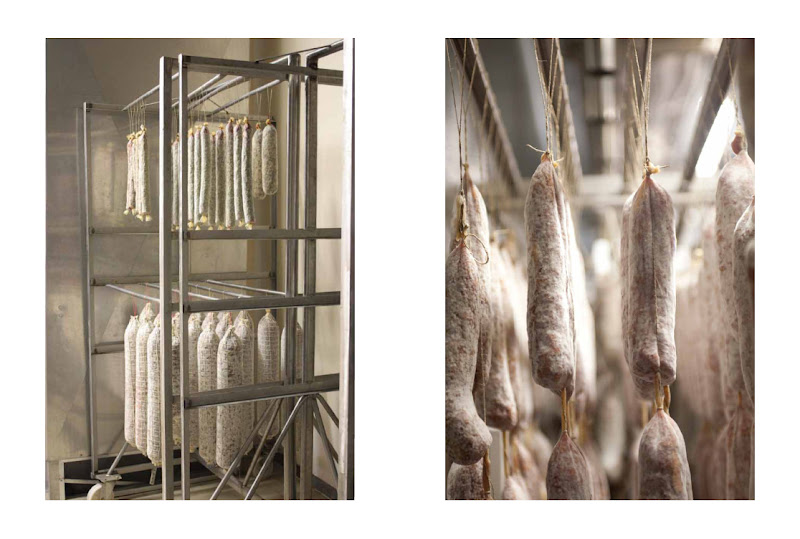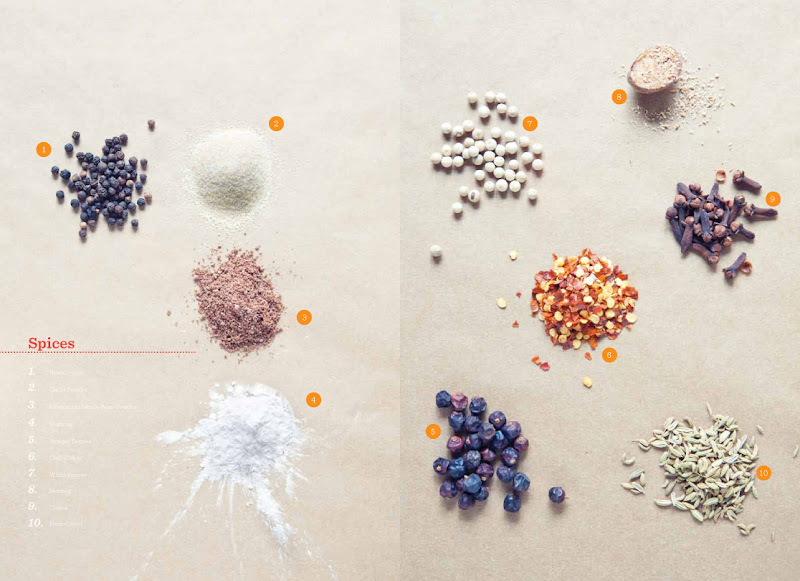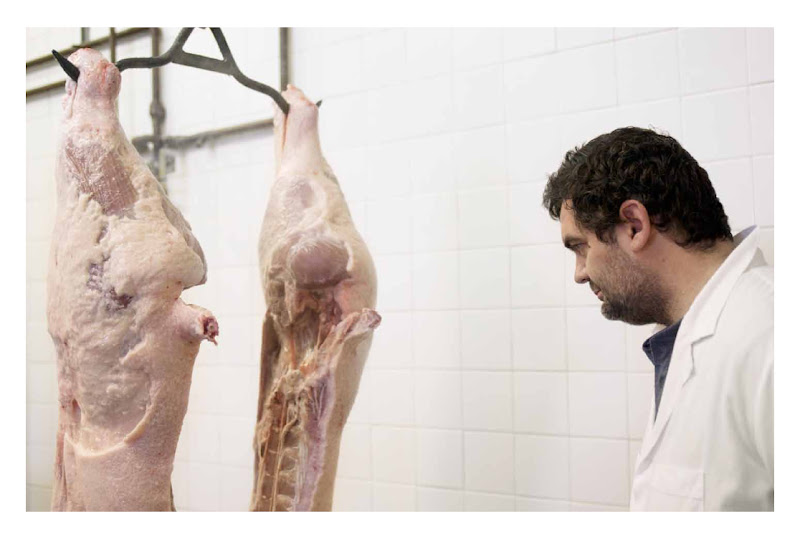
(photo: the varying parts of a pig, photo courtesy of Meat Salt Time by Tony Seichrist)
Some of the more popular salumi in Italy include, Cotechino
or Zampone, Guanciale, Lardo, Pancetta, Salame, Salame genovese di
Sant’Olcese, Felino, ‘Nduja, Soppressata, Ciauscolo, Prosciutto, Prosciutto
di Parma, Prosciutto di San Daniele, Speck, Culatello (a personal
favorite), Culaccia / Culatta, Prosciutto cotto, Capicola (another
personal favorite), etc. See my guide to salumi for more information.

great salami starts with a high quality pig, such as Duroc, Ossabaw,
Mangalitsa, Pata Negra, etc. And salumi such as Felino or Soppressata
are made from different parts of the pig including the neck, belly,
loin, jowl, etc. The pig parts need to be ground before the spicing
and stuffing process can begin. And as you probably guessed, both the
lean and fatty parts of the pig are used during the grinding process
(in fact, this is a key step because a good salumi needs a good ratio
of fatty to lean meat). Before the grinding takes place, most salumi
makers coarsely chop their cuts of meat and thereafter it goes through a
coarse grind plate. Next, the meat is ready for salt and spice.
use high quality sea salt and spices such as black pepper, garlic
powder, nutmeg, dextrose or sugar, chili flakes, cloves, fennel seed,
juniper berries, white pepper, etc. The spices vary according to the
type of salumi being produced, but most salumi are usually comprised of
about 3% salt.

spices used by Creminelli. photo courtesy of Meat Salt Time by Tony
Seichrist)
salumi mixture is stuffed into a natural casing and tied and the
critical fermentation process begins. During the fermentation process,
they key goal is to control temperature and humidity. As Seichrist
explains:
“The temperature and humidity are primed for
bacterial growth, and the sugars in the recipe provide food for the
growing culture. As the bacteria begin to multiply and consume the
sugars, there is a sudden drop in PH. It is this sudden lowering of
the pH that renders salumi completely safe to eat.”
The
fermentation process also allows the salt in the meat to pull the water
out of the salumi (this is what “drys the salumi and the high humidity
during the process prevents the meat from drying out too much”). The
ideal temperature at the beginning of the fermentation process is about
73-75 degrees with humidity close to 100 percent. After about 10
hours, the humidity level needs to be dropped to 60 percent (for about
5 hours) with a gradual drop in temperature, as well. After the 5
hours the humidity level is raised slowly (during a 4-5 day process) to
about 75-85 percent with a temperature between 55-60 degrees. The
salumi stay in the aforementioned environmental conditions (usually in
a curing cell when making large production batches) for about 17 days
(during which critical mold and bacteria is created as well), in total.
the salami making process and how high quality artisan producers such
as Creminelli make their products? If so, enter to win your very own copy of Meat Salt Time ; the book includes some of the best food photography I’ve seen(!):
The contest is open until 12 midnight on 10/4 and a single (1) random
user will be picked via Random.org (sorry contest only open to folks
from the US given shipping logistics). The winner will be announced
immediately on Twitter (so please follow me) and on Scordo.com by 8PM
on Tuesday, 10/7.
needed): 1. Become a fan of Scordo.com on Facebook (if you’re a fan
already please “share” the page on your Facebook account) and 2. leave
a comment here on your favorite food process, that is, something like
making salami that you know well (e.g., making homemade pasta or fried
chicken).



My favorite food process is baking bread.
I am also infatuated with salami and the process of making salami, but unfortunately I have yet to read a book that outlines a way for the home enthusiast to successfully accomplish this. I am hoping this book does that!!
I’m a fan on Facebook and one of my favorite food processes is to made and can fruit preserves (personal favorite is wild huckleberry)!
Hi Bryan, I just updated the entry with three other book recommendations that offer a more detailed view of how to make salumi, have a look at the end of the entry.
Vince
I think my favorite process is making pastries. In baking, there is exactness but at the same time a creativity that follows the experienced baker. Once you’ve mastered the process of the science, you’re free to embellish and make the recipe your own.
Vince, Thanks for you kind comments about Meat Salt Time.
My pleasure!
Vince
Recipe: Escarole and Bean Soup
(photo: escarole and bean soup. note this picture shows cranberry beans and brown rice)Recently, I’ve developed quite the craving for hardy greens such as Swiss chard, red chard, bitter dandelions, kale, and escarole. Maybe it’s a function…
Review: Columbus Wine Salame and Limited Edition Porcini and Truffle Artisan Cacciatore
(photo: Columbus Artisan line seasonal cacciatore) I’ve written about Columbus’ Artisan salumi line in the past (including their hot sopressata, cacciatore, finocchiona, crespone, salami secchi, and standard Sopressata) and their high-end line is outs…
Pancetta, Bacon, and Cured Pork Perfection
By now, you’ve read my countless references to salame, prosciutto, capicola, cured pork, etc. and you may be thinking: what’s wrong with this guy, does he have a thing for pigs or something? The short answer is yes and…